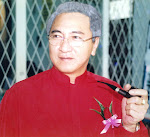
Sunday, 28 June 2009
Today the Church celebrates : St. Irenaeus, Bishop and Martyr (+ 202)
Saint Irenaeus was born about the year 120. He was a Grecian, probably a native of Lesser Asia. His parents, who were Christians, placed him under the care of the great St. Polycarp, Bishop of Smyrna. It was in so holy a school that he learned that sacred science which rendered him afterward a great ornament of the Church and the terror of her enemies. MORE ...
Holy Gospel of Jesus Christ according to Saint Mark 5:21-43.
When Jesus had crossed again (in the boat) to the other side, a large crowd gathered around him, and he stayed close to the sea. One of the synagogue officials, named Jairus, came forward. Seeing him he fell at his feet and pleaded earnestly with him, saying, "My daughter is at the point of death. Please, come lay your hands on her that she may get well and live." He went off with him, and a large crowd followed him and pressed upon him.
There was a woman afflicted with haemorrhages for twelve years. She had suffered greatly at the hands of many doctors and had spent all that she had. Yet she was not helped but only grew worse. She had heard about Jesus and came up behind him in the crowd and touched his cloak. She said, "If I but touch his clothes, I shall be cured." Immediately her flow of blood dried up. She felt in her body that she was healed of her affliction.
Jesus, aware at once that power had gone out from him, turned around in the crowd and asked, "Who has touched my clothes?" But his disciples said to him, "You see how the crowd is pressing upon you, and yet you ask, 'Who touched me?'" And he looked around to see who had done it. The woman, realizing what had happened to her, approached in fear and trembling. She fell down before Jesus and told him the whole truth. He said to her, "Daughter, your faith has saved you. Go in peace and be cured of your affliction."
While he was still speaking, people from the synagogue official's house arrived and said, "Your daughter has died; why trouble the teacher any longer?" Disregarding the message that was reported, Jesus said to the synagogue official, "Do not be afraid; just have faith." He did not allow anyone to accompany him inside except Peter, James, and John, the brother of James.
When they arrived at the house of the synagogue official, he caught sight of a commotion, people weeping and wailing loudly. So he went in and said to them, "Why this commotion and weeping? The child is not dead but asleep." And they ridiculed him. Then he put them all out. He took along the child's father and mother and those who were with him and entered the room where the child was. He took the child by the hand and said to her, "Talitha koum," which means, "Little girl, I say to you, arise!" The girl, a child of twelve, arose immediately and walked around. (At that) they were utterly astounded. He gave strict orders that no one should know this and said that she should be given something to eat.
"The child is not dead but asleep"
Every gospel reading, Beloved, is most helpful both for our present life and for the attainment of the life to come. Today's reading, however, sums up the whole of our hope, banishing all grounds for despair. Let us consider the synagogue official who took Christ to his daughter and in so doing gave the woman with a hemorrhage an opportunity to approach him... Christ could foresee the future and he knew this woman would approach him. Through her the Jewish official was to learn that there is no need to move God to another place, take him on a journey, or attract him by a physical presence. One must only believe that he is present in the whole of his being always and everywhere, and that he can do all things effortlessly by a simple command; that far from depriving us of strength, he gives it; that he puts death to flight by a word of command rather than by physical touch, and gives life by his mere bidding, without need of any art...
So when Christ reached the house and saw the mourners lamenting as though the girl were dead, he declared that she was not dead but sleeping, in order to move their unbelieving minds to faith and convince them that one can rise from death more easily than from sleep. «The girl is not dead,» he told them, «but asleep.»
And indeed, for God death is nothing but sleep, since he can raise the dead to life more quickly than we can rouse a sleeper... Listen to the Apostle Paul: «In an instant, in the twinkling of an eye, the dead will rise» (1Cor 15,52)... How could he explain its swiftness verbally when divine power outstrips the very notion of swiftness? How could time enter the picture when an eternal gift is given outside of time?


.jpg)




No comments:
Post a Comment